Michael Whelan In Conversation 1997
An interview shortly after the first Tree's Place Exhibition

The following is a conversations with Michael Whelan that took place shortly after his first one man show at Tree’s Place in Orleans, MA.
While Michael had been devoting time to his personal visions for more than a decade, the success of this show led to another exhibition in 1999 and his eventual departure from illustration as he began to focus primarily on his gallery work.
For decades, Michael tried to find a creative balance between fine art and illustration before announcing his retirement from illustration this August.
For a long time, you’ve talked about splitting time between illustration and your fine art work. What does each mean to you?
Well, my illustration was always my guiding light through the years. It was what I loved to do the most as a child and what I always sought to do and denied myself until I was almost through college, but once I started getting work as an illustrator it was the realization of a dream.
What I wanted to do more than anything was to be a pilot or an astronaut, but I couldn’t do that. Then I had other goals, like any person who does something creative. You’re setting new horizons for yourself.
Once I actually started making a living as an illustrator doing book covers, which was something I thought I’d never really get to, then it was a question of—well, I’ve always wanted to do the John Carter Mars series and boom I got the assignment. These things just kind of came to me.

I started meeting each goal. There began to be fewer and fewer goals in the realm of illustrator that I wanted to accomplish. I became aware after awhile of a growing need to paint the things that I was coming up with on my own, and each succeeding year it got more frustrating to just stick them in the file drawer and put them aside. I kept trying to make time for myself to do the work and it wouldn’t happen.
When I did LUMEN 4, I had the underpainting done in 1992 or something. It sat there in my studio and I saw it virtually every day that I went in to do my illustration work. There’s only so long that you can turn your back to something like that. It is a very compelling vision, it was something I wanted to paint, and every day I had to turn my back to it.
So it was a long process of learning to say no to the comfort of a well established career, which provided me all the benefits one could ask for. I was paid well for it and got awards and adulation and everything else. I’d pretty much reached the peak of what I could get to doing fantasy and science fiction book cover illustrations.
That’s what illustration meant to me.

My art, what that means to me…I feel it’s the art of my maturity. People often ask me why I didn’t turn to doing my personal work before and to be honest I don’t think before 1988 I was really ready to.
I think that my skills had to mature to a certain level and I had to undergo certain personality changes and maturation of…thought, about how I perceived the outside world and my relationship to it and other things…having two children…all the other things that come with living my life as I’ve lived it.
I feel eminently ready to do that now, but I really think it would have been too early if I’d started in my twenties, for example, doing only my work. I think it would have been indistinguishable from my illustration. In fact, it was.
Whenever someone asked me what I do for myself, up until 1987 my answer was always my illustration is the work I do for myself because that’s what I chose to do. Up until ’87 or ’88, that’s all I envisioned myself doing, but something happened. It might have something to do with being a parent…I don’t know.
The ideas started coming to me were not connected to stories. They’re more connected to an alteration of my vision. Joni Mitchell in a recent interview in Vanity Fair said that artists are people who perceive the world in metaphors.
I don’t think that was true of me when I was younger, but there has been a change in me and it’s definitely true of me now. It happens all the time. I catch myself doing it and I can kind of step outside of myself and say isn’t it cool that that’s happening, but there’s another practical side of me that says this is really important and this is something I should use in my art to express the things I was to express.
Anyway, those all add up to my perception that my illustration as being something I did when I was younger, and my personal work as something I think is more an expression of my age and maturity now. I don’t mean to suggest in saying this that illustration is only something for kids…is a matter of being immature. I think that the best illustration stands up to the best fine art
It’s just that Illustration is not enough for me any more, unfortunately. I never thought that that would happen.
How many ideas had you filed away at the point where you knew you had to focus on your personal art?
File drawers full. For every book cover I did, I would do a minimum of 2 to 12 concept sketches. And sometimes, especially for the anthologies where all I had to do was a painting that was a riff on a theme, say that there’s a collection of horror stories…well, it just had to be a disturbing painting. Well a lot of times what I would choose to do with that cover would be something that reflected personal issues or things that were happening in my life.
So, a lot of personal subjects came up as alternate concepts for book covers that didn’t get chosen and I would take the concept and either photograph it and keep the slide as a reference for a future, larger painting, or I would actually keep the concept or sketch and stick it in the file drawer. I had piles and piles of those after awhile. Well, especially with the anthologies that happened.

I remember the first one that really made a big impact aside from the horror stories ones was 1985 I had been commissioned to do a cover for a book called Distant Stars. The publisher said just come up with anything you want based on the title…it’s a collection of short stories by Samuel R. Delaney.
I thought that “distant stars” was really evocative and I came up with all kinds of metaphysical, far out concepts…and Samuel Delaney didn’t like any of them. He wanted something that was a lot more obviously science fiction and they gave me something that I ended up altering and using as the idea for the cover. I had probably eight concepts that I thought all would have made really nice paintings.
One of them had a number of children on a sphinx-like carving. It’s the obvious precursor to SENTINELS. It’s night time and they’re looking out over this vast desert and there’s like a nebula setting in the distance.
It’s in my last book [The Art of Michael Whelan]. I’ve had a lot of inquiries about it and people have seen it. So I think it would have struck a chord with people if I had painted it then. I don’t know what it means anyway. It’s just a riff on the title. There’s not a lot of significance to it. That’s the first one I can think of that got me thinking about doing paintings that were totally self-derived.

How hard was it to break away from illustration for you?
It was really hard because I only worked with people that I enjoyed working with, so it meant saying no to people who were friends of mine basically. People at DAW Books and TOR and some of the other book companies I worked with—I know them on a fairly personal basis, so to say no I’m not going to work here any more is hard to do.
It was that and the money. It was very sobering when my last check came from a publisher. It felt very much like I was stepping off a gang plank…going off into free fall, because there was no money coming that I could see.
Money did come from royalties and other sources and things that happened, but at the time I didn’t know how we were going to survive and I kind of give Audrey a lot of credit for having faith in me. I was in free fall for awhile, full of self doubt not sure if I was doing the right thing or not.
I kind of hedged my bets. I took some long term assignments just in case. So that’s why I’m doing a book cover next month. That’s why I did MeatLoaf’s album cover and things like that. I’ve since realized that that was unnecessary.

Did you have any hesitation as to whether you’d be able to bridge over to fine art and be able to do that as a career?
I didn’t know whether I’d be able to pull it off or not because in spite of the fact that American history is full of examples, artists who were illustrators who became recognized fine artists—Edward Hopper and Winslow Homer come to mind, but there are Frederick Remington—there’s a lot of them. It doesn’t happen so much in modern time, especially when the illustrator has been doing something that is looked down upon such as fantasy and science fiction work.
Yeah, I was very unsure and it was only by chance that I found Tree’s Place. I don’t know what would have happened. I’ve been showing my work in some galleries with mixed success and the people who buy my work seem to be fairly ardent and loyal supporters, but you need a certain amount of those to actually make a living at it, so I had no assurance whatsoever that I was going to be able to successfully pull it off.

You’re looking at a different audience for your work. How did that affect you?
You obviously seem to pull out some of the same elements…there are some very science fiction elements to your work, particularly the Fading Star series, which have been used for covers.
What would you perceive your audience being as far as your fine art?
As far as my fine art, my audience as such is only myself. When I go into my studio to paint, ever since AVATAR, it’s hard to do but I really remove all consideration of what my audience is and I paint solely to please myself.
When I was in my younger years, especially when I was an illustrator, if I heard an artist say that I’d say, “balogna…what a bunch of crap.” But now I’m saying it and I expect other people to say that about me, but it’s really true.
The reason I don’t quite like SENTINELS as much as some of my other paintings is that there are elements in there—things about that painting that look the way it does because I couldn’t quite let go of considering my audience.
I remember when I was painting AVATAR, there was part of my mind trying to convince myself to put in a figure because people expect there to be a figure in my paintings…and I like painting figures, but the original concept of the paintings which I had in the float tank there were no figures in that.
When I painted AVATAR and THE RED STEP, [I said] I’m just going to be true to the initial concept and paint it as I see it. In both cases, I got such positive response to the paintings that it really surprised me. I honestly didn’t think anybody would like either of them, especially RED STEP.
It took Audrey a lot of time to convince me to even take it to a show because it was so drab in color it seemed to me when actually it’s won ribbons. It really caught me by surprise. It was a great affirmation.

It was so different and so cutting edge for you.
Yeah, it broke those barriers for me. I’ve had nothing but encouragement.
I remember when David Bowie did the Low album. I don’t know if you’re familiar with his career or not. He went to Germany and just to satisfy his contract he had to do an album. He chucked everything in his pop career and did this electronic album. Half of it is depressing German Euro-synth music.
It was an incredible breakthrough album. It influenced many, many musicians. It was a huge influence on me. It caught me totally by surprise when people came back to me and told me they thought it was great.
The same thing happened to me with my personal work. Every time I take that attitude when I do a painting, I say lets see what they think of this. I had this dream and it sure is a wacky concept and it’s such a weird composition, but I’ll go ahead and do it anyway and see what happens.
Every time I do that, I get nothing but a positive response, so I’ve had nothing but encouragement. So I guess I’ll keep on going like that and hopefully it’ll reinforce in me confidence in my own vision. I won’t dilute it with considerations of who my audience is.
The show at Tree’s Place was the first major exhibition of your personal work, where you’re showing it all in a collection to an actual audience. In terms of your career goals, how important was that for you?
It was immensely important. Everything else in my career as far as my personal work is concerned seems to hinge on this show to a certain extent. I’ve been selling paintings here and there, but to open them up to an audience with some intent—I don’t know how else to put it—to say “here they are world, give me your response all in one grouping” is kind of what I need to do at this point to direct me in my next two years worth of work.
If I didn’t sell a single piece in the show and felt that people didn’t do the work, I really think I would still paint it because it’s really important to me. And how I feel when I’m doing the painting is half the reason why I’m doing it.
Now that the show seemed to be a great success—you sold a lot of paintings before the show even opened—where does that take you now?
I’ll probably do a lot more because we have all these bare spaces on our walls. Audrey is really upset.
I feel that some massive doors have been opened up for me. I’ve had a lot of ideas lingering on the edge that are a little bit more extreme than the things I’ve done up till now, and it really makes me want to kick open the doors to those things and go ahead and do them now and just keeping reaching outwards. It’s such a wonderful sense of affirmation I have. I feel really gratified that people like my work.

Someone managing my career would say that I should never admit that I’m surprised when people are buying the work, but I am because a painting like SUBTERRANEANS is for me so intensely personal, so much so that when people ask me for a detailed explanation about it, sometimes it’s hard for me to articulate exactly. To know that I’m at least communicating the subjective undercurrent that’s a great feeling. It feels like I’m succeeding in something.
To me that’s the measure of success of the painting is whether or not people are getting the base things that I’m trying to communicate, which is the subjective content, the emotion. If they get anything else on top of that that’s fine. That’s gravy as Arthur C. Clarke said.
Even now if someone sees THE RED STEP and stares at it and seems to enjoy it, the main emotion I feel is wonderment that it’s working for them too. I certainly had no one else in mind when I painted the painting.
Now that you’ve actually taken some time off and done a considerable amount of work on your fine art, do you have a picture of the grander vision of the work? It seems to fall in different series.
No, I’m trying to avoid doing that because the chief problem about my illustration career is that it very much directed me into a product driven mentality. You’re delivering a product at a specified time of deadline to a person who is paying for it. I think it’s very important for an artist to be more process driven than product driven. I’m trying to make my life now about the process of making art than product.
I realize that my personal mythologies and symbols are falling into groupings that I’ve given titles to, but I have no intention of setting a limit or an endpoint to any of these. I think I’ve got to let my life direct and alter and evolve with these. I have to let a series evolve with my life and my outlook as time goes on rather than set some sort of artificial endpoint or final statement.
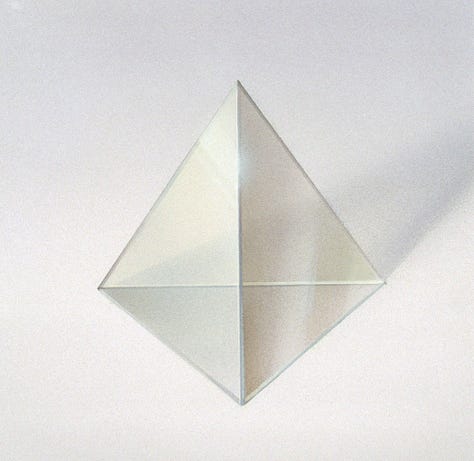
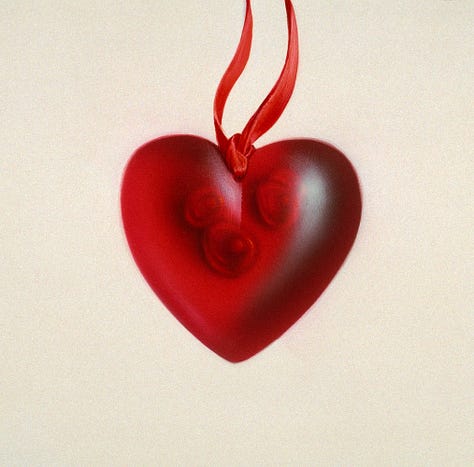
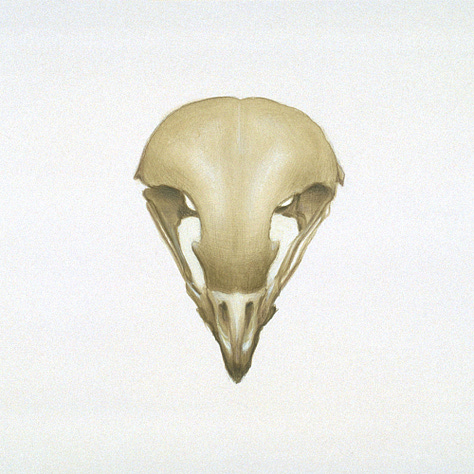
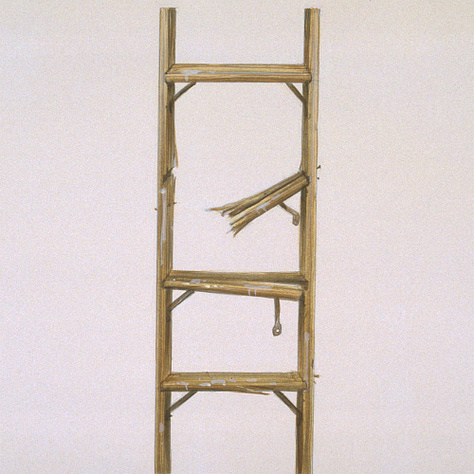

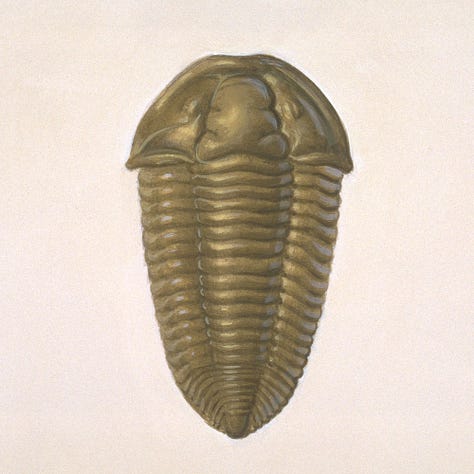
I’m as surprised as the next person half the time when some of these ideas come to me and tell me that they need to be painted, especially the ones that come in my dreams. I don’t know where they come from, but they feel important and they feel like…when the concept comes to me I feel that it has to be me that paints it. There is a sense of that.
Most of the time, I know what the painting is about before I do them, but I can’t say that I consciously have an idea where they come from. Yeah, I’ve got generalized ideas of sizes and shapes and some elements in the immediate future. I know that in the next six months I want to do more paintings with figures in them. I want to do more large ones and more small ones. I want to do some round paintings and work with some other shapes that I haven’t worked with.
The beginning of your fine art came with the Passage series, which means a lot of different things. You talk about it most obviously as being a bridge between mediums or going from acrylics, which you favor to oils, which you’re becoming more familiar with.
Yeah, that part hasn’t worked out. I don’t know how I’ll make it happen, but I’m going to. I’m determined to do more of my work in oils.
I keep falling back into needing to use airbrush when I paint in acrylics. When I paint works smaller, I don’t feel like I need it to create a blend. The larger the blend has to be, the harder it is to do it all by hand. I so dislike using an airbrush. I really want to get used to doing more of my work in oils so I can avoid using an airbrush.
CAUSEWAY was in oils, but CAUSEWAY almost was a total disaster because of the problems I had with the varnish on it. My oil painting career is somewhat checkered, but that’ll change. I just have to use it more often.
I’m just so familiar with acrylics. I’ve been using them day in and day out virtually for 20 odd…22 years, so it’s like second nature to me.

What are the differences between the mediums for you?
Acrylics are so forgiving, especially if you’re working on a gesso panel. There’s no mistake you can make that can’t be sanded off and fixed. So as far as I’m concerned, it’s the ideal medium for illustrators because it allows unlimited number of changes and fix up. It dries so quickly.
You don’t have all the problems you do with oils…with having to let a painting dry for 6 months before you put the final picture varnish on it. If you want to get work done quickly and proceed on the next project, it seems like acrylics are really made for that. You get less dust in the paints. All of my oil paintings act like dust magnets. I find that really annoying.
The thing about oils is the smell of turpentine when you walk into the studio. For me, it is an indescribable sensory experience. When I walk into my studio and if I smell oil paints or turpentine, there is a romance to it that I guess harkens back to my teenage years when I first became acquainted with oils and I took some figure painting classes.
When I think of painting and being an artist, I think of oil paints, but when I have a dream I want to realize quickly and see really quickly, I go to acrylics because I want to get done and see it quickly if I can. I have a love of both mediums. They just have a different feeling.
If I’m working quickly in oils, they tend to show brushwork a lot more and become a lot more expressive. You wouldn’t know it but some of the paintings I’ve done like CAUSEWAY, which is tightly controlled. When I painted CAUSEWAY, I had a sense of trying to retain a sense of control over the medium so that it felt like my acrylic paintings. Does that make sense?
If you look at some of my oil painting sketches, they’re a lot freer and Frazetta-ish. I hate to use that term, but everyone knows what I mean when I say that. I’ve been accused of letting him influence me, but that’s just the way I paint when I’m painting in oils and I’m painting quickly. I’m not satisfied with leaving it that way, actually. I usually tighten things up, because I want a more complete vision for the paintings.
I feel good when I sit down and paint in oils. I feel good when I’m painting in acrylics. It’s just like two different friends with two different personalities. Sometimes one feels right with one subject, and sometimes one feels right with another subject.
Talking about Passages, other than the literal meaning between mediums, what other kinds of Passages?
Well, there was the obvious passage of me going from painting in illustration to stepping off the edge. There are a lot of edges and people stepping off edges and taking chances in some of the paintings I’ve done since I decided to embark on this.
I was conscious of that when I painted Alexa on that thing. It wasn’t her stepping off. It was me too. That was one passage.

The core theme really was a spiritual one and that being the transition from life to death. I got involved in thinking a lot about and questioning my concepts or lack of concepts about the whole issue of spirituality and life after death—thinking of my religious background and my rejection of it. The paintings have a lot to do with that.
AVATAR is about on one level getting past the structure of dogma in organized religion. That’s what the crumbling arches are about. I’ve never explained it before, but that’s what I was thinking when I decided to make them. The avatar is a star on the horizon calling the spheres of consciousness.
I always thought if such a thing exists…I just thought the idea of an avatar and of life after death is a beautiful idea even if it’s not reality. We won’t know until we die. I think the idea is beautiful enough for a painting to be done about it. Even if at some point I decide I’m a total atheist or not, I don’t see myself ever rejecting the painting because I think the painting is worthy of exploration.
I was raised a Catholic. I’ve had a number of things happen in my life that make me conscious that there’s a lot more to reality than what can be scientifically proven. So when scientists tell me that it’s this way or that way, I have a sense of cynical doubt about the firmness of their affirmation. I question that. I know my feelings suggest to me that there might be something to metaphysics, but I’m not sure anybody really has a handle on it.
That’s interesting because for a while you considered going into medicine—into a scientific profession. Is that part of the reason for your change? Is that logically in line that you had doubts at that point?
No. You mean doubts about religion?
You said that you don’t necessarily believe science is…
Well, yeah. When Sherwyn Nuland, who wrote How We Die, says that he thinks out of body experiences or near death experiences are just non-sense, I think you can’t say one way or another. He’s saying what he believes, and there are other people expressing the other side. We won’t know one way or the other.
There are some things that happen in life like experiencing a clairvoyant moment or seeing a UFO that if it happens to you and you’ve experienced it, then you can answer for yourself whether there is something that you believe in or not. It’s never possible to totally convince somebody else who didn’t experience it…one way or the other.
I would love to see a flying saucer and know for sure whether they’re real or not. I don’t want to die, but I’d really like to see that question answered for me. But I know there is such thing as clairvoyance because I’ve had situations happen to me that have proven its existence to me and it’s unexplainable by our current state of science.
If that thing can be real, something that can not be measured effectively yet by any known form of science…can’t be proven or disproven through scientific means…if such a thing as that exists, it opens the door to believing that maybe well maybe perhaps some other things exist like the possibility of existing after death. There being an inextinguishable spirit within people that survives death and goes to some other state.
I think it’s a beautiful idea and it’s certainly an alluring one because none of us wants to face up to our own mortality and believe it’s just the end. I’ve felt this way for quite a while, but I’ve never felt a need to express it artistically, but I do now.

You said that you’ve experienced moments of clairvoyance?
Oh yeah.
What type of an experience is that? Can you describe it?
Oh sure. I was fairly strongly clairvoyant when I was a senior in high school.
I’d say during my entire senior year in high school, I knew whenever a pop test would happen the next day or not. I remember at least on two occasions studying for a test the night before and just knowing that the test wasn’t going to happen, even though we’d known from the beginning of the school year that there was going to be a test on a certain day. I’d close my book and go watch TV or read a comic and the next day I’d go to class and the teacher was sick that day and didn’t show up.
What’s amazing to me in retrospect is that I didn’t think it was anything special. I just kind of accepted it and never remarked on it to anybody, until I had a dream once.
When I had dreams that happened, they always had a special clarity to them. Two things happened. There was a special clarity to them and I always woke up in the middle of the night when I had the dream and had to go back to sleep again.
And I had one dream I remember about the sequence of events that was going to happen the next day. I remember it really clearly like I had the dream last night. The next morning I remember mumbling to my sister over breakfast that I had this dream and in the dream I was in the school play and I went to the stage to rehearse and the teacher was there with a couple students standing next to her. She looked up from her clipboard and said, “What are you doing here? Didn’t you hear we cancelled rehearsal tonight?”
I go like this [slaps head] and I turned around and opened the door and run after my girlfriend, who I had said goodbye to. She was heading back home. Usually I walked her home everyday after school. And then half way to running to where I usually met her, I realized “oh yeah…that’s right. She got a ride home.” How I knew that I don’t know. She had a ride home from somebody so I’ll just go home and call her up at home.
Anyway, I told my sister this and she probably doesn’t remember it now. Anyway, that happened.
After school, I went to the rehearsal and the teacher was there. The reason I hit myself in the head is I said I dreamed all this. I knew it was going to happen. I ran to the spot and I knew that my girlfriend had a ride home. I got home and called her up and her best friend had given her a ride home because she’d driven her car to school that day. It all happened. So I knew that I’d dreamt it—that I didn’t make it up during that day somehow because I’d told my sister about it that morning.
Anyway, I had things like that but gradually during my college years, especially during my freshman year it started to wain and went away by the time I was halfway through college.
I personally have a deep and abiding conviction that there is more to intellect than what can be determined through scientific tests, at least at our present state of knowledge. We have to remember that things such as radioactivity and magnetic fields were totally unknown to us until the ability came for us to detect them later. It’s quite possible at some point in the future that we’ll be able to measure and quantify these phenomenon, but right now we can’t so a lot of people persist in denying that they exist.
Sometimes it comes back to me. We were coming home from something…Audrey and I…and I started slowing down. She said, “What’s the matter?” and I said, “I just think we’d better slow down. There may be a deer in the road or something.” We turned the corner and there were three deer on our street right here. So it happens once in awhile. It could be coincidence. But later on in my college years, I met a man who was truly clairvoyant. So far beyond the realm of coincidence that it was ridiculous.
Weekly Art Recap
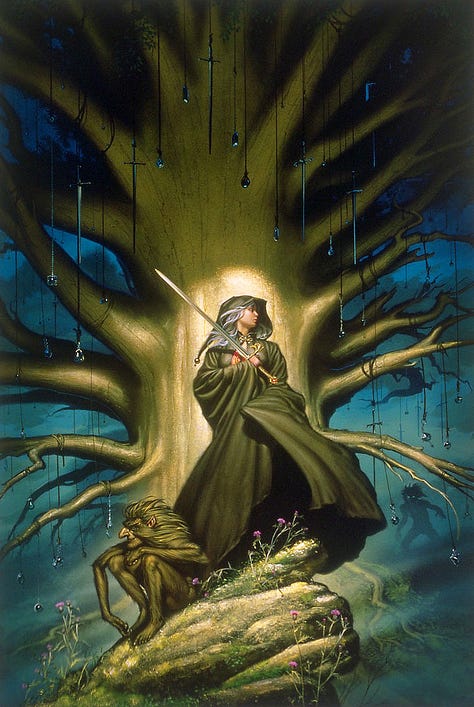
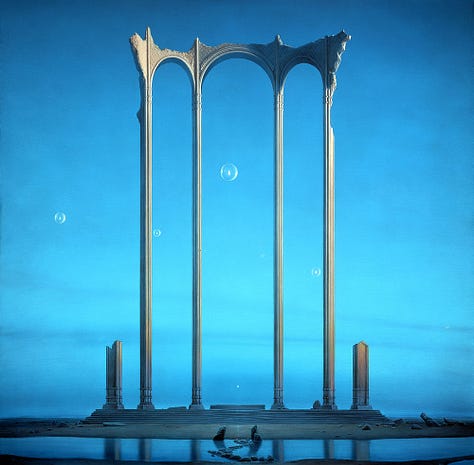
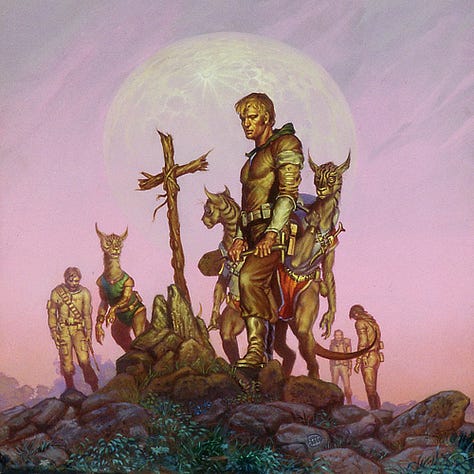
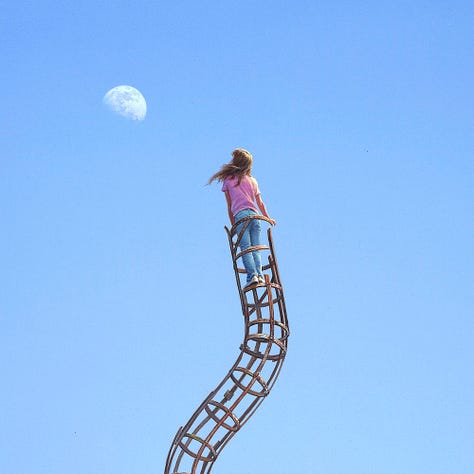
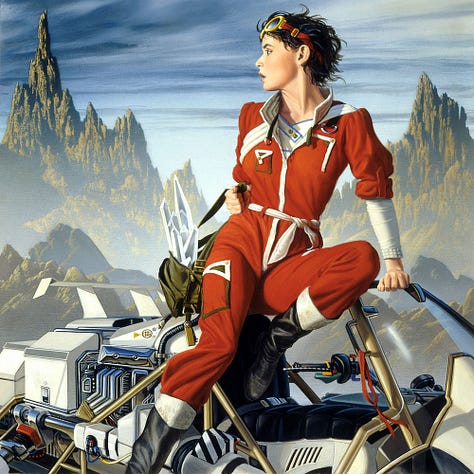
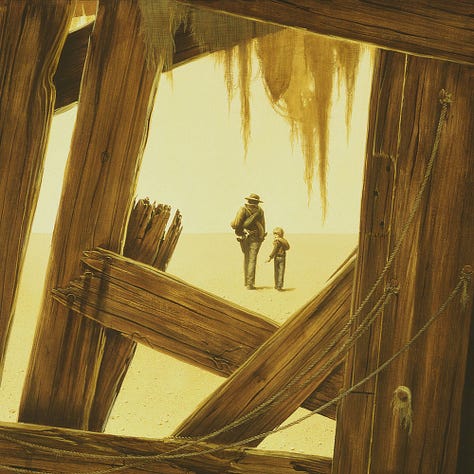
Tree of Jewels and Swords - fan favorite cover for C.J. Cherryh’s Arafel books
The Avatar - float tank vision and first painting in the Passage series
Question and Answer - classic cover for grandmaster Poul Anderson
Ellie’s Dream - a personal vision with a small connection to Carl Sagan’s Contact
Killashandra - cover for Anne McCaffrey’s second Crystal Singer book
The Way Station - endpaper illustration for The Gunslinger by Stephen King
What Would You Ask Michael?
I’ve had some interesting conversations with Michael since that interview back in 1997. I was 25 years old at the time and only knew him through correspondence. I’ve gotten to know him much better now, of course, but looking back I’m not sure I would approach our conversation all that differently today.
If you had the opportunity to ask Michael one question (then or now), what would it be? Hit me with your best and we’ll see what answers Michael might provide next week.
Coming Soon…Leftovers & Palette Gremlins
We kicked off the 2024 gallery in style with a new Elric titled CHAOS ABIDES. Now Michael is launching back into outer space for his next L&PG.
Paid supporters will get an advanced preview in a separate email before the gallery reveal on Wednesday (9/18) at 11am EST. This small original painting will be available in the shop at the same time.






I particularly love the use of symbolism in Michael’s work. Some are obvious and others you really have to look for. My question is: What is one of your personal favorite symbols in your work (a certain painting or one that reappears in many) that you love but people tend to miss?
I've always loved Michael's work, whether illustration or original. I'm curious if (other than Audrey, Alexa, Adrian or yourself) you imagine the people you paint in either format, if you use models or if you're inspired by faces you see when out and about. Thanks!